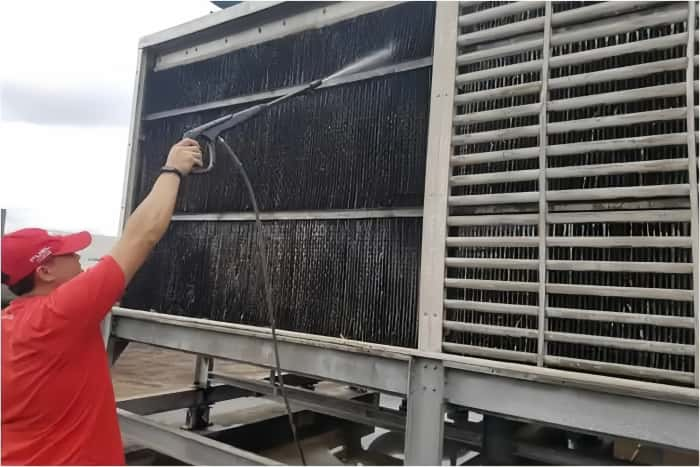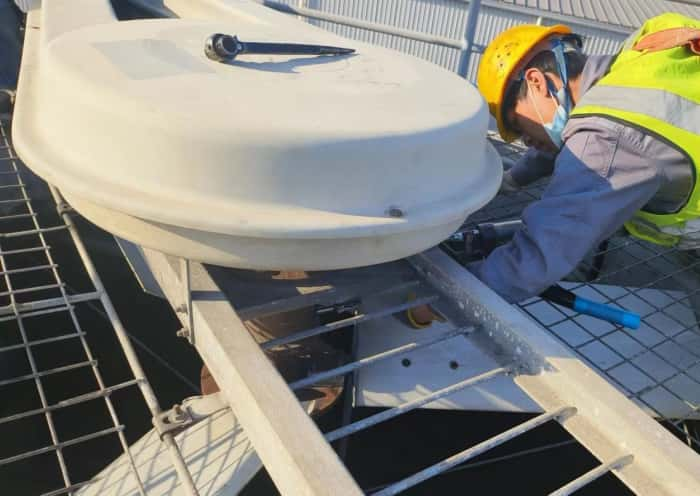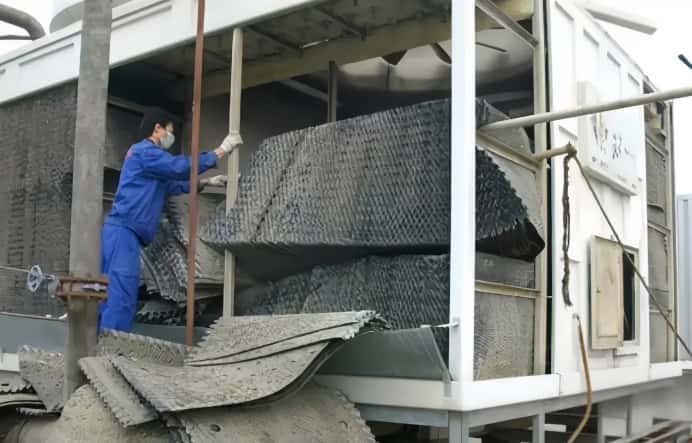Cooling tower fills are facilitating heat exchange between water and air. However, over time, they become prone to scaling, deformation, aging, sediment buildup, and algal growth. These issues lead to clogging, reduced heat transfer efficiency, and, in severe cases, compromised cooling performance and increased energy consumption. Regular cleaning cooling tower fill and maintenance of cooling tower fills are essential to extend their lifespan and maintain optimal cooling efficiency.
Benefits of Regular Cooing Tower Fill Cleaning
1. Improved Heat Transfer Efficiency
- Cleaner surfaces for better evaporation: Fills are designed to maximize water-air contact for efficient evaporative cooling. Dirt, algae, and mineral deposits reduce this contact area. Regular cleaning restores the fill's heat transfer capacity.
- Better water distribution: Clean fills ensure uniform water spread, avoiding hot spots or insufficient cooling.
2. Prolonged Equipment Lifespan
- Corrosion prevention: Deposits and sludge not only hinder heat exchange but also promote corrosion of metal components. Clean fills reduce internal erosion and extend equipment durability.
- Biological control: Biofilms formed by algae and bacteria reduce efficiency and contribute to biological corrosion. Regular cleaning helps prevent microbial growth.
3. Energy Savings
- Lower power consumption: Blocked fills require increased fan speeds or water pumping to maintain cooling, resulting in higher energy usage. Clean fills optimize performance at minimal energy cost.
- System efficiency boost: Well-maintained fills prevent localized failures that may trigger wider system malfunctions, ensuring stable and efficient operation.
4. Safety and Compliance
- Legionella prevention: Stagnant, untreated water in dirty towers can harbor harmful bacteria such as Legionella, posing public health risks. Cleaning helps mitigate this threat.
- Environmental compliance: Many regions enforce strict discharge standards. Regular fill maintenance helps control pollutants and ensures regulatory compliance.
Implementation Recommendations
- Create a maintenance schedule: Tailor the cleaning/replacement frequency based on the tower's usage and environmental conditions.
- Use appropriate cleaning methods: Depending on the fill type and level of contamination, employ physical methods (e.g., high-pressure washing), chemical treatments, or a combination.
- Keep detailed maintenance records: Document all cleaning activities (dates, methods, materials used) to track results and inform future maintenance plans.

Cleaning Tools and Methods
1. Tools Required
- High-pressure water gun: Effectively removes stubborn dirt and algae. Ensure proper pressure settings to avoid damaging the fill material.
- Brushes (wire or nylon): Used for scrubbing persistent residues. Wire brushes target tough grime; nylon brushes are gentler on delicate surfaces.
- Chemical cleaners: Choose non-corrosive agents suited for the fill material and contamination level. These help break down biofilm and mineral scales.
- Personal protective equipment (PPE): Includes gloves, goggles, masks, and protective clothing to ensure worker safety.
- Additional tools: Water hoses, buckets, brooms, soft brushes, and temporary soaking tanks (e.g., plastic-lined pits).
2. Step-by-Step Cleaning Procedure
- Manual Pre-Cleaning: With PPE on, manually remove loose dirt and debris from the fill using brooms or brushes.
- High-Pressure Washing: Thoroughly spray the fill surface to dislodge algae, dirt, and accumulated residues.
- Chemical Soaking (if needed): For persistent scaling and biofilm, remove the fill and soak it in a chemical solution. Duration depends on contamination level and cleaner instructions.
- Final Rinse: After soaking, rinse with high-pressure water until runoff is clean and free from chemical residue.
- Biocide Treatment: Apply biocides or algaecides to inhibit microbial regrowth. Ensure compatibility with the fill material.
- Inspection and Replacement: After cleaning, inspect for damage or aging. Replace severely deteriorated fills.
- System Recovery and Testing: Refill the tower, run operational checks, and ensure normal cooling performance.
Maintenance Tips
- Use water treatment systems to reduce scaling and microbial growth.
- Install drift eliminators to minimize water loss and airborne contamination.
- Regularly inspect for cracks, warping, or clogging in fills.
- Replace heavily damaged fills rather than relying solely on cleaning.
- Maintain accurate logs of inspections and cleanings.

Conclusion
Neglecting fill maintenance leads to higher energy bills, frequent breakdowns, and potential health hazards. A clean, well-maintained cooling tower delivers peak performance, improved safety, and long-term savings. Make cooling tower fill cleaning a core part of your maintenance strategy—your equipment and your budget will thank you.
